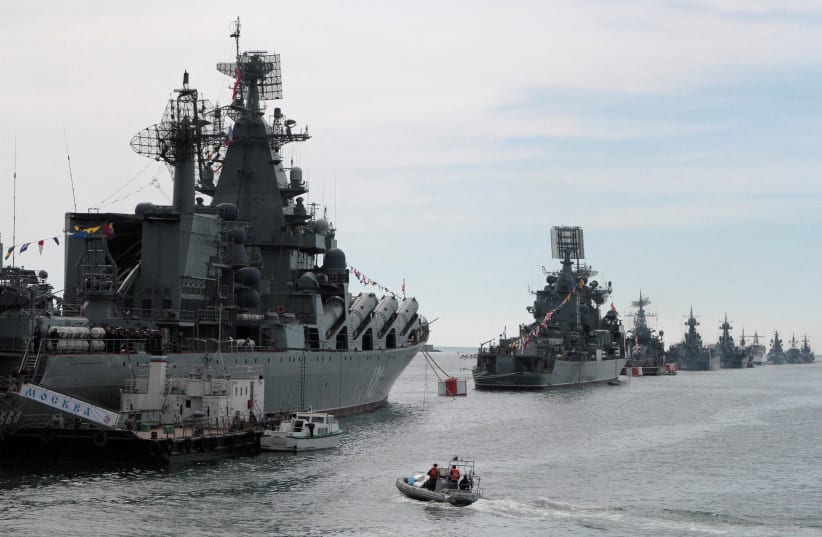A large Russian naval landing force of 12 landing ships is reportedly "ready to perform tasks for its intended purpose in the Black Sea," according to Russian state media outlet TASS.
Massive landing force
"For the first time, such a large grouping of the Russian Navy operates in the Black Sea, which consists of twelve large landing ships of the Northern, Baltic and Black Sea fleets. These BDKs (large landing vessels) are now ready to perform their intended tasks as part of a special military operation," a source in the Crimean authorities told TASS.
According to the source, the flotilla of 12 vessels includes three large landing craft from Russia's Northern Fleet, three from the Baltic Fleet, and six from the Black Sea Fleet. Naval News reported the movement of these craft into the Black Sea prior to the war.
Possible amphibious assault
It is unclear what the source meant by the force's "intended tasks." The large landing vessels are capable of beaching and unloading soldiers and vehicles for amphibious assaults, as well as transporting significant amounts of war materials to ports.
Since the war's beginning, the Ukrainian military has expressed concern about the possibility of an amphibious assault on the vital Ukrainian port city of Odesa. Russian forces are also pushing toward Mykolaiv, according to Friday morning Ukrainian and UK intelligence updates.
However, an amphibious assault would "be extremely difficult, particularly since their forces would be vulnerable," RAND National Security Supply Chain Institute director Captain (ret.) Bradley Martin told The Jerusalem Post. "If they tried to put a bunch of amphibious troops and assault force into an amphibious task force and they tried to move them toward Odessa, it's very obvious that they're coming. They're easy to detect, and a lot of them will get sunk. It would probably be very difficult for Russia to carry off an invasion like that."
Martin said that such an operation wouldn't entirely "off the table, but it would be very expensive, very risky and very difficult for them to carry out." A landing would need to be done in a completely benign environment to mitigate the risks.
Previously, landing vessels such as the Tapir-class landing vessels Orsk and Saratov were used to resupply troops and to attempt to strengthen Russian supply lines.
When the Black Sea Fleet began to deliver ammunition and equipment to Russian forces fighting in the Mariupol region through the occupied Ukrainian port of Berdyansk in late March, a Russian Black Sea Fleet officer told the Zvezda outlet that it opened "opportunities for the Black Sea Fleet in logistical matters."
However, the Saratov was sunk in the Berdyansk port by a Ukrainian ballistic missile strike, and two Ropucha-class landing ships, Tsezar Kunikov and Novocherkassk were reportedly damaged.
Martin told the Post that "it's not really clear that those ships add materially to the ability to supply. Russia is a lot better off relying on internal supply lines."
Large landing vessels
The flotilla is comprised of the Iven Gren-class Pyotr Morgunov and the Ropucha-class Olenegorsky Gornyak and Georgy Pobedonosets from the North Fleet; the Ropucha-class ships Korolev, Kaliningrad and Minsk from the Baltic Fleet; and the Ropucha-class Tsezar Kunikov, Novocherkassk, Azov, Yamal and Tapir-class Orsk and Nikolay Filchenkov.
Altogether, the flotilla could transport around 4,000 infantrymen and around 150 main battle tanks at once.
Vulnerability to anti-ship missiles
Since the sinking of the Black Sea Fleet flagship Moskva using two Neptune land-to-sea anti-ship missiles, according to the Ukrainian military, Russian vessels have been keeping their distance from the coast.
"I would say that they appear to have gravely underestimated the threat that did occur from land-based anti-ship cruise missiles, and they appear to have taken not taking any sort of effective measures to prevent such attacks which would indicate to me a certain level of underestimation of the threat and surprise at what occurred [with the Moskva]."
Captain (ret.) Bradley Martin
"What they have done is they have tried to complicate Ukraine's targeting by not being so close that they could be seen from shore, and by doing that Ukrainian batteries could no longer just shoot them like fish in a barrel," said Martin.
Since the Moskva's destruction, Ukraine has enlarged and enhanced its arsenal of anti-ship missiles. The UK has provided Brimstone missiles after British Prime Minister Boris Johnson promised them to Ukrainian President Volodymyr Zelensky in early April. Ukraine also began to receive Harpoon missiles in late May from Denmark.
These weapon platforms provide a serious challenge to Russian naval activity in the Black Sea, and a hurdle that the landing ship force must overcome to meet their "intended tasks" — whatever that might be.
"Surface ships in this day and age are very vulnerable to attack once they're located," noted Martin, who explained that there were some measures that could be taken to avoid being hit by anti-ship missiles, such as varying movements, electronic emission control, using decoy signals, point defense systems, and electronic warfare systems to alter missile trajectories away from the ship.
Another major impediment to an amphibious landing would be sea mines. Both Ukrainian and Russian forces have been accused of using mines during the war — some have become untethered and have migrated to Romanian and Turkish waters.
A minefield, or the threat of one, would increase the risk calculations for any flotilla, limiting possible movement and maneuvering. Demining is a time extensive process.
Reuters contributed to this report.
